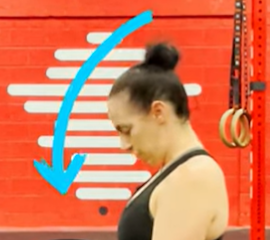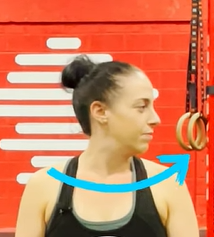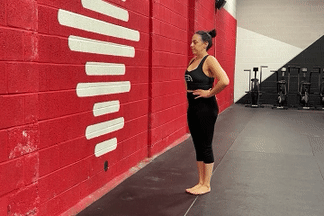If you’re dealing with neck pain, you’re not alone. Many people experience neck pain or stiffness occasionally.
Everyday activities like sitting at a desk for extended periods, leaning over your phone or tablet, and even sleeping in an awkward position can contribute to neck pain. This pain can range from mild discomfort to outright agony and can be exacerbated by physical activity.
But the good news is that there are exercises you can do to help improve mobility and combat neck pain. These exercises range from simple stretches that you can do at your desk or in front of the TV to more intensive strength-building exercises that can be done with dumbbells or a resistance band.
What neck exercises can you do to reduce neck pain and improve mobility?
Neck pain is not something to be taken lightly. As the muscles around your neck get tight and tense, they can start pulling on your spine, leading to further issues.
So, what neck exercises can you do to reduce neck pain and improve mobility? 😱
You can start by focusing on stretching and improving your posture. Simple exercises such as the chin to chest and side-to-side stretches can help relieve tension in the neck muscles. It would help if you also focused on good posture while sitting or standing to reduce strain on the neck.
It’s important to remember that neck exercises are only part of the solution. In addition to exercise, you should also consider changing some of your everyday habits.
Make sure you take regular breaks from sitting in the same position for extended periods and avoid looking down at your phone or tablet for too long.
This article will discuss exercises to help ease neck pain and improve mobility.
✨Why Neck Pain Is Common, and Some of the Causes
Neck pain is a common complaint among adults. Whether you wake up with an aching neck from sleeping in the wrong position or experience stiffness after hours of sitting at a desk, neck pain can be both annoying and debilitating.
✊Here are some of the common causes:
🤕Poor posture while sitting or standing
Poor posture can hurt your neck. Sitting or standing in a way that is not good for your body can cause pain in your neck. This pain can last a long time, making it hard to move your neck the way you want. Posture can also affect other parts of your body, such as your spine and back muscles.
🤕Stress and tension
Stress is a part of life but can also contribute to neck pain. When you feel anxious or stressed about something, your body will tense up, which can cause tightness and pain in your neck.
🤕Injury
Injuries from accidents falls, sports injuries, and other physical activities can cause neck pain. In some cases, the damage may cause long-term pain and require medical attention.
🤕Lifestyle factors
Smoking, obesity, and inactivity can all contribute to neck pain. The more active you are, the better your posture and overall health, which can help reduce neck pain.
🤕Muscle strain
Overuse of muscles in the neck can cause strain and pain. This is especially true if you have certain occupations or engage in activities that require repetitive motions over long periods, such as typing on a computer or playing a musical instrument.
🤕Arthritis
Arthritis affects the joints and can cause pain in your neck. This is more common in older adults and can be treated with medication or lifestyle changes.
🤕Aging
Neck pain prevalence peaked during the middle ages and declined thereafter, with the highest burdens being seen in men and women aged 45–49 and 50–54.
As we age, our bodies naturally become more prone to pain and stiffness. Bones and joints in the neck can become weaker over time, leading to increased discomfort.
🌟The Importance of Mobility and Range of Motion in the Neck
Mobility refers to your ability to move your body freely and easily. Good mobility is critical to healthy living, as it helps you to stay strong and flexible.
Mobility in the neck is especially important because it helps you to move your head and neck in all directions. This is key for activities like looking up, down, and side-to-side. A lack of mobility can result in stiffness, discomfort, and even pain.
Range of motion is another crucial factor for neck health. Range of motion refers to how far you can move a joint or muscle without feeling discomfort or strain.
A good range of motion in the neck is important for many reasons. It can help reduce stiffness and pain, improve posture, and increase flexibility. Additionally, a full range of motion enables you to perform everyday tasks efficiently.
Mobility and range of motion in the neck area can be affected by factors like injury, arthritis, posture, and lifestyle. Improving mobility and range of motion can help improve your overall neck health and reduce pain.
🏆Benefits of Neck Exercises
Neck exercises help strengthen the muscles in your neck, increase your range of motion, reduce stiffness, and improve posture.
Here we will discuss five benefits of doing neck exercises.
💯Improved mobility
Regular neck exercises can help increase your neck’s range of motion, which enables you to move more freely without feeling discomfort or pain. This is especially important if you have an injury or suffer from arthritis, as it helps keep the joints flexible and reduces stiffness in the area.
💯Reduced muscle tension
Neck exercises also help relieve muscle tension which often leads to headaches and other forms of pain. They work by stretching out tight muscles around your spine, which allows them to relax, so they don’t pull on your vertebrae, causing further issues down the road, such as pinched nerves or herniated discs.
💯Better posture
Good posture is essential for keeping our bodies healthy since it helps us maintain proper alignment throughout our body, including our spine and shoulders. By doing specific stretches for our necks, we can ensure that these areas are properly supported and improve our posture.
💯Stronger muscles
Doing neck exercises can strengthen the muscles in your neck, which helps provide more support and stability for your spinal column and other parts of the body. This helps protect us from further pain or injury down the road.
👊Neck Exercises to Improve Mobility and Reduce Stiffness
There are a variety of exercises you can do to help improve mobility in your neck. Here are some of the most common ones:
Chin to chest
Gently lower your chin to your chest and hold for 5 seconds, then come back up. This exercise will help stretch your neck muscles and improve your range of motion.
Hide side-to-side stretches
To do this exercise, slowly move your head from side to side as far as possible without straining the muscles. Hold each position for 5 seconds before switching sides. Make sure you hit each side twice. You can do this exercise while sitting in your work area or standing.
Turn head
Turn your head to one side as far as you can and hold for 5 seconds. Next, do the same for the opposite side and hold for 5 seconds. Repeat 2 more times but be gentle to yourself. You need to feel that range of motion but don’t overstretch.
Chicken neck
This exercise is simple but effective. Bend your neck forward for 5 seconds and pull it back.
Release the head back
So we’re going to release the head back, turn to the shoulders back, open up through the upper back and hold for 5 seconds. Again be gentle to yourself; no need to push too far.
 Shoulder shrugs
Shoulder shrugs
Shoulder shrugs are a great way to improve mobility, reduce stiffness, and strengthen muscles in the neck and shoulders. To do this exercise, stand up straight with your arms at your sides, slowly raise your shoulders towards your ears, and then drop them back down. Repeat this several times to get the full benefit of the exercise.
Chin tucks
Involve gently tugging your chin towards your chest and holding the position for a few seconds. To do this, place your fingertips at the base of your skull and pull gently forward. Then, hold that position for a few seconds before releasing it.
These are just a few exercises that can help improve mobility in your neck, reduce stiffness, and combat pain.
If you have persistent pain in the neck, it is vital to seek professional help from a healthcare provider as soon as possible. They can help determine the cause of your pain and provide appropriate treatment options.
Read more about neck stretching: 📍Neck Pain No More! An Easy-to-Follow Guide to Stretching Your Neck
🔥Tips for Keeping your Neck Healthy and Pain-Free
A healthy and pain-free neck is vital to leading an active and productive lifestyle. Here are some tips to help keep your neck healthy:
✅Practice good posture
Poor posture can cause neck and shoulder tension, leading to pain. Keep your back straight, and your shoulders relaxed when sitting or standing, and try to avoid hunching over.
✅Avoid staying in one position for too long
Sitting or standing in the same position for a prolonged period can cause your neck muscles to become stiff. Instead, make sure to take frequent breaks and move around. This will help loosen up your muscles and reduce tension.
✅Maintain a healthy weight
Being overweight can put extra strain on the neck, leading to pain and other health issues. Eating nutrient-dense foods and exercising regularly can help you maintain a healthy weight and keep your neck strong.
Here are some articles you might find useful if you’re interested in weight management:
- 📍8 Best Calisthenics Exercises Without Equipment for Weight Loss
- 📍5 Ways Calisthenics Helps You Lose Weight Fast
- 📍7 Best Exercises for Losing Weight
✅Avoid carrying heavy bags or purses on one side of your body
Try to spread out the weight evenly between both sides of your body. Carrying large, heavy bags on one side can cause muscle structure imbalances, leading to neck pain.
These are just a few tips to help prevent neck pain. It is important to remember that if you experience any sharp or
✅Get regular exercise
Regular exercise helps strengthen the muscles that support your neck, reducing pain and stiffness. Simple neck exercises such as neck stretches and rotations can help keep your neck healthy.
✅Take regular breaks from screens
Staring at a computer or phone screen for too long can cause tension in the neck and shoulders. Make sure to take frequent breaks and look away from the screen every 20 minutes. This will help reduce neck strain.
✅Apply heat or cold therapy
After long days at work or strenuous exercise, applying heat or cold therapy to the neck can help reduce pain and stiffness. The heat helps to increase circulation and relaxation in the tight muscles, while ice helps reduce inflammation. You can also use massage therapy to help relax the muscles and improve mobility.
Taking care of your neck is vital to maintain a healthy lifestyle. By incorporating these tips into your daily routine, you can keep your neck healthy and pain-free!
🧐Frequently Asked Questions
🔎What activities can cause neck pain?
Activities that involve repetitive motions or strain on the neck muscles can cause neck pain. These activities include lifting heavy objects, sitting at a desk, and using a computer for extended periods.
🔎Is it normal to have neck pain?
It is not normal to have persistent neck pain. However, if you are experiencing neck pain, it is crucial to see a healthcare provider as soon as possible. They can help determine the cause of your pain and provide appropriate treatment.
🔎What can I do to prevent neck pain?
Practicing good posture, avoiding staying in one position for too long, maintaining a healthy weight, getting regular exercise, taking breaks from screens, and applying heat or cold therapy can help prevent neck pain. Additionally, you can perform simple neck exercises to maintain neck strength and flexibility.
🔎How can I tell if my neck pain is severe?
If you are experiencing sharp pain in the neck, numbness or tingling in the arms or legs, frequent headaches, dizziness, and difficulty swallowing or breathing, these could be signs of a severe condition. Therefore, seeking medical attention is essential if you experience any of these symptoms.
🔎What postural changes can reduce the strain on the neck and shoulder muscles when sitting or standing for long periods?
You can use postural changes to reduce the strain on your neck and shoulder muscles when sitting or standing for long periods. Make sure to keep your back straight, and your shoulders relaxed. You should also avoid leaning forward and hunching over, as this can stress the neck muscles. Additionally, take frequent breaks and move around to help relax your neck muscles.
🔎Can I use exercise equipment for neck exercises?
Yes, you can use exercise equipment for neck exercises. For example, using an exercise ball or foam roller can help strengthen and stretch your neck muscles. You can also use light weights to add resistance when performing neck exercises. Consult with a healthcare provider before beginning any new exercise program.
🔎What calisthenics routine can help address neck pain?
A calisthenics routine that targets the neck muscles can help address neck pain. Exercises such as neck rolls, shoulder shrugs, and side-bends can help stretch tight muscles and improve mobility. Additionally, using your body weight for resistance exercises such as planks or push-ups can provide a good workout for the neck muscles.
🔎What self-care techniques can I use to relieve neck pain?
In addition to stretching and strengthening exercises, there are other self-care techniques you can use to relieve neck pain. For example, applying heat or cold therapy can help reduce inflammation and improve circulation in the area. Massage therapy is also beneficial for relaxing tight and achy muscles. Finally, practicing good posture throughout the day can help prevent neck pain from occurring in the first place.
🔎What exercises should I avoid when I have neck pain?
Avoiding exercises involving heavy lifting or jerking motions is essential when you have neck pain. Additionally, any exercise that causes sharp or sudden movements should be avoided until your pain has subsided.
By following these tips and taking the necessary steps
🔎Is it safe to do neck exercises if I have neck pain?
Certain exercises may be contraindicated depending on the severity and cause of your neck pain. Your healthcare provider can identify safe exercises for your specific condition and guide you in performing appropriate form and technique when doing those exercises.
📌Takeaway
Neck pain is not normal and should be addressed as soon as possible. Poor posture, injury, muscle strain, and stress and tension are some of the causes of neck pain.
Improving your neck’s mobility and range of motion can reduce stiffness and pain.
Additionally, many different self-care techniques can help reduce and manage neck pain, such as practicing good posture, taking frequent breaks from screens, stretching and strengthening exercises, applying heat or cold therapy, massage therapy, and avoiding activities involving heavy lifting or jerking motions.
Interested in improving your overall fitness goal in a personalized, adaptive, and progressive manner?
TAKE YOUR ASSESSMENT NOW!
Learn impossible skills, build insane functional strength, lose fat, and have fun with The Movement Athlete.







 Shoulder shrugs
Shoulder shrugs
